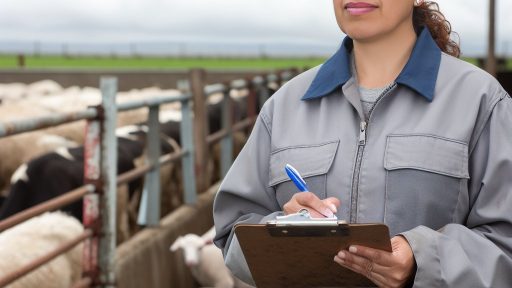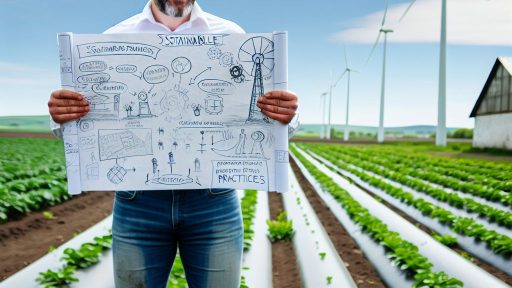Introduction to Renewable Energy Subsidies for Farmers
Renewable energy subsidies can significantly benefit farmers.
These subsidies promote the use of sustainable energy sources.
Farmers can save money while enhancing their operations.
Various government programs offer financial assistance.
Subsidies can take many forms, including grants and tax credits.
Understanding the Importance of Renewable Energy
Renewable energy helps reduce dependence on fossil fuels.
This transition supports environmental sustainability.
Additionally, it can lower energy costs for agricultural producers.
Farmers can take advantage of diverse energy sources.
Solar, wind, and biomass are popular options among agriculturalists.
Types of Subsidies Available
Farmers can access various subsidies for renewable energy projects.
Federal programs are available through the U.S. Department of Agriculture.
State and local governments often provide additional support.
Common subsidy types include:
- Investment tax credits
- Production tax credits
- Loan guarantees
- Grants for energy efficiency improvements
Navigating the Application Process
Applying for renewable energy subsidies may seem daunting.
Transform Your Agribusiness
Unlock your farm's potential with expert advice tailored to your needs. Get actionable steps that drive real results.
Get StartedHowever, understanding the process can make it easier.
Farmers should start by conducting thorough research.
Identifying applicable programs is crucial for success.
Additionally, gathering necessary documentation helps streamline applications.
Challenges and Considerations
Farmers face challenges when applying for subsidies.
Funding availability and eligibility criteria can be complex.
Moreover, competition for grants can be intense.
Farmers must stay informed about deadlines and requirements.
Seeking guidance from experienced professionals can be beneficial.
Types of Renewable Energy Subsidies Available
Direct Financial Incentives
Direct financial incentives provide immediate support for farmers investing in renewable energy.
These incentives can come in the form of grants or cash payments.
Government programs often fund these subsidies, helping to offset installation costs.
Examples include the Renewable Energy for America Program (REAP).
This program offers grants for renewable energy systems and energy efficiency improvements.
Tax Credits and Deductions
Tax credits significantly lower the tax burden on farmers adopting renewable energy technologies.
The Investment Tax Credit (ITC) is one prominent example.
This credit allows taxpayers to deduct a percentage of solar energy system costs from their federal taxes.
Moreover, farmers can benefit from production tax credits for wind energy production.
Low-Interest Loans
Low-interest loans enable farmers to finance renewable energy projects affordably.
Programs like the USDA’s Rural Energy for America Program (REAP) provide these loans.
These loans often cover up to 75% of project costs.
Favorable terms make the transition to renewable energy viable for many farmers.
Feed-in Tariffs and Power Purchase Agreements
Feed-in tariffs guarantee a fixed price for energy produced from renewable sources.
These tariffs encourage investment in renewable energy projects by ensuring revenue stability.
Showcase Your Farming Business
Publish your professional farming services profile on our blog for a one-time fee of $200 and reach a dedicated audience of farmers and agribusiness owners.
Publish Your ProfilePower purchase agreements (PPAs) establish long-term contracts for energy sale.
These agreements provide predictable income, reducing financial risks for farmers.
State and Local Incentives
In addition to federal subsidies, state and local programs offer varied incentives.
These can include tax abatements, rebates, or grants tailored to regional needs.
Farmers should research incentives specific to their location.
Often, local agricultural departments provide information on available resources.
Technical Assistance Programs
Technical assistance programs help farmers navigate renewable energy options.
These services can guide them through project assessments and feasibility studies.
Programs may also connect farmers with experienced contractors and engineers.
Utilizing these resources leads to well-informed decision-making.
Eligibility Criteria for Farmers to Apply for Subsidies
Understanding the eligibility criteria is crucial for farmers.
First, you must be an active farmer to qualify for subsidies.
Your farm must meet specific size requirements designated by legislation.
Additionally, farms should demonstrate a commitment to sustainable practices.
This often includes using renewable energy sources in operations.
Furthermore, you must comply with local environmental regulations.
Each state may have unique rules, so it’s essential to research your area’s requirements.
Moreover, farmers may need to provide documentation proving their practices.
For example, records of energy usage and conservation methods may be necessary.
It’s beneficial to seek guidance from agricultural extension offices.
They can offer tailored advice based on your specific situation.
In some cases, formulating a business plan highlighting your sustainability efforts is beneficial.
This plan may help in demonstrating your commitment to renewable energy.
Moreover, participating in educational programs can strengthen your application.
Such programs often cover the latest trends in renewable technologies.
Finally, staying updated on federal and state funding opportunities is crucial.
These programs frequently evolve based on political and environmental factors.
Meeting eligibility criteria requires diligence and awareness.
By understanding these aspects, you can successfully apply for renewable energy subsidies.
Delve into the Subject: Soil Conservation Rules Explained
Step-by-Step Guide to Applying for Renewable Energy Subsidies
Understanding the Requirements
Start by researching the specific subsidies available in your area.
Each program has unique eligibility criteria.
Gather necessary documents, such as proof of ownership and tax records.
Ensure your renewable energy project meets local regulations.
Furthermore, verify the types of renewable energy that qualify for subsidies.
Identifying Relevant Subsidy Programs
Visit government websites for up-to-date information on subsidies.
Look for programs at the federal, state, and local levels.
Consider joining local agricultural associations for guidance.
Networking with other farmers can provide valuable insights.
Moreover, keep track of deadlines for each program’s application period.
Showcase Your Farming Business
Publish your professional farming services profile on our blog for a one-time fee of $200 and reach a dedicated audience of farmers and agribusiness owners.
Publish Your ProfilePreparing Your Application
Begin crafting your application well in advance.
Include all necessary documentation to support your request.
Be precise in detailing your renewable energy project.
Clearly outline how your project contributes to sustainability.
Additionally, ensure your application is free of errors.
Submitting Your Application
Follow the specific submission guidelines provided by each program.
Submit your application through the designated channels.
Check if electronic submission is available for convenience.
After submission, save confirmation receipts and documentation.
Furthermore, maintain copies of everything you send.
Follow-Up After Submission
Monitor the status of your application regularly.
Be prepared to answer additional questions from the review committee.
If you face delays, reach out to the appropriate office for updates.
Consider asking for feedback if your application is denied.
Lastly, remain patient, as approval processes can take time.
Learn More: Navigating Regulations Of Agricultural Conservation Programs
Renewable Energy Technologies Beneficial for Farming
Solar Energy Solutions
Solar energy is increasingly popular among farmers.
It provides a reliable power source for various farm operations.
Farmers can install solar panels on rooftops or land.
This option reduces electricity costs significantly.
Moreover, solar energy helps in maintaining sustainable practices.
Wind Energy Applications
Wind turbines can harness natural wind for energy production.
This technology is particularly useful in open fields.
Farmers may install small-scale turbines for personal use.
These turbines can reduce reliance on fossil fuels.
Furthermore, wind energy systems complement other renewable technologies.
Biomass Energy Utilization
Biomass energy provides an excellent alternative fuel source.
Farmers can convert waste materials into energy.
This process benefits both energy production and waste management.
Using biomass reduces greenhouse gas emissions significantly.
Additionally, it’s a sustainable practice that can generate income.
Geothermal Energy Potential
Geothermal energy is an often-overlooked resource.
This technology taps into the Earth’s natural heat.
Farmers can use it for heating buildings and irrigation systems.
It’s a consistent energy supply that lowers operational costs.
Moreover, geothermal systems are low-maintenance and efficient.
Hydropower Versatility
Hydropower offers another viable renewable energy solution.
Farmers with access to streams or rivers can harness this energy.
This resource can supply power for irrigation and machinery.
Small-scale hydropower systems are environmentally friendly.
Showcase Your Farming Business
Publish your professional farming services profile on our blog for a one-time fee of $200 and reach a dedicated audience of farmers and agribusiness owners.
Publish Your ProfileThey help reduce dependency on non-renewable energy sources.
Integration of Technologies
Farmers can benefit from integrating multiple renewable technologies.
This strategy enhances resilience against fluctuating energy prices.
Combining solar and wind, for example, maximizes energy production.
Such integration creates a sustainable and effective energy system.
Additionally, it supports long-term agricultural goals.
See Related Content: The Importance of Food Safety Standards in Agriculture
Case Studies: Successful Implementation of Renewable Energy on Farms
Solar Power Success at Green Valley Farms
Green Valley Farms harnessed solar energy effectively.
Their installation consisted of 500 solar panels.
This setup generated 150,000 kilowatt-hours annually.
As a result, they reduced their energy costs by 40%.
Moreover, they adopted battery storage to enhance efficiency.
This innovation allowed energy use during non-sunny hours.
Farm owner Lisa Carter emphasized the importance of sustainability.
She observed a significant reduction in carbon emissions.
Wind Energy Adoption at Oak Ridge Dairy
Oak Ridge Dairy explored wind energy as an alternative.
They installed two wind turbines on their property.
These turbines produced around 100,000 kilowatt-hours each year.
This move helped enhance their profitability significantly.
Furthermore, it increased farm resilience against energy price fluctuations.
Owner Mark Thompson found this investment worthwhile.
He highlighted the long-term financial and environmental benefits.
Biogas: A Game Changer for Maple Leaf Farms
Maple Leaf Farms embraced biogas technology successfully.
Their anaerobic digester processed waste from their poultry operations.
This process generated approximately 80,000 cubic meters of biogas annually.
This biogas provided heat and electricity for the farm.
As a result, they reduced reliance on fossil fuels dramatically.
Additionally, the system improved waste management practices.
Owner Sarah Nguyen noted the competitive edge gained through this technology.
Geothermal Heating at Sunny Acres Greenhouse
Sunny Acres Greenhouse implemented geothermal heating effectively.
They drilled wells to tap into the earth’s thermal energy.
This system maintained optimal growing conditions year-round.
Consequently, it reduced heating costs significantly during winter months.
Owner Tom Baker praised the environmental impact of this choice.
He noted an increase in crop yields due to stable temperatures.
Moreover, geothermal energy offered a sustainable alternative to gas heating.
Lessons Learned from These Case Studies
Each case demonstrates renewable energy’s potential in farming.
Transitioning to green energy sources brings economic savings.
Additionally, it enhances environmental stewardship across the industry.
Moreover, collaboration with local energy advisors improved outcomes.
Showcase Your Farming Business
Publish your professional farming services profile on our blog for a one-time fee of $200 and reach a dedicated audience of farmers and agribusiness owners.
Publish Your ProfileFarmers should consider diverse renewable options tailored to their needs.
Adopting innovative technologies leads to greater resilience and profitability.
Gain More Insights: Enhancing Farm Operations Through Animal Welfare Compliance

Financial Impacts of Renewable Energy Subsidies on Farming Operations
Overview of Renewable Energy Subsidies
Renewable energy subsidies offer financial assistance to farmers.
These subsidies promote the adoption of sustainable energy sources.
They can significantly lower the cost of energy production.
Subsidies may reduce overall operational costs for farming activities.
Types of Renewable Energy Subsidies
Farmers can benefit from various types of subsidies.
These include tax credits, grants, and low-interest loans.
Incentives may apply to solar, wind, and biomass projects.
Each type has unique advantages for farming operations.
Short-Term Financial Benefits
Subsidies can lead to immediate financial relief.
Lower energy costs enhance cash flow for farmers.
They also reduce reliance on fossil fuels.
Consequently, farmers can reinvest savings into their operations.
Long-Term Economic Impact
Long-term savings can accumulate through renewable energy use.
Farmers often experience reduced maintenance costs over time.
Investing in renewable energy increases farm value.
These investments can make farms more resilient to market fluctuations.
Case Studies of Successful Implementation
Many farmers have successfully benefited from subsidies.
The Johnson Family Farm installed solar panels last year.
They report savings of over 30% on their energy bills.
Similarly, Green Valley Farm invested in wind turbines.
They have seen a remarkable return on investment.
Challenges and Considerations
Adopting renewable energy solutions isn’t without challenges.
Initial setup costs may be high for some farmers.
There may also be a learning curve for new technologies.
Farmers must carefully evaluate their energy needs.
They should assess the feasibility of different renewable options.
Navigating the Application Process
Applying for renewable energy subsidies can be complex.
Farmers must gather necessary documentation and data.
It’s essential to understand federal, state, and local programs.
Working with experts can simplify the application process.
Consulting energy specialists can improve chances of success.
Future Trends in Renewable Energy and Farming
The future of farming is increasingly tied to renewable energy.
Innovations are continually emerging in energy technologies.
New policies may enhance subsidy availability.
Farmers who adopt these technologies may gain a market edge.
Renewable energy presents a viable path for sustainable farming.
Future Trends in Renewable Energy Subsidies and Farming
Emerging Technologies
New advancements in renewable energy technologies emerge rapidly.
Showcase Your Farming Business
Publish your professional farming services profile on our blog for a one-time fee of $200 and reach a dedicated audience of farmers and agribusiness owners.
Publish Your ProfileFarmers will increasingly utilize solar panels and wind turbines.
These innovations significantly enhance energy efficiency on farms.
Moreover, battery storage systems will improve energy management.
Farmers should stay informed about technological developments.
Policy Shifts
Government policies surrounding renewable energy are evolving.
Anticipate a shift towards stronger incentives for green technologies.
Farmers can benefit from enhanced subsidies in the coming years.
Understanding these policy changes is crucial for financial planning.
Active participation in local agricultural organizations is beneficial.
Market Opportunities
Growing consumer demand for sustainable products presents opportunities.
Farmers can tap into markets focusing on eco-friendly practices.
Incorporating renewable energy can enhance product appeal.
Furthermore, participating in carbon credit programs may be profitable.
Success depends on farmers adapting to market trends.
Sustainability Practices
Farmers are increasingly adopting sustainable practices.
These practices benefit both the environment and business profitability.
Investing in renewable energy reduces reliance on fossil fuels.
Furthermore, sustainability enhances farm resilience against climate change.
Understanding and implementing these practices is essential for future growth.
Community Engagement
Collaboration within agricultural communities will strengthen efforts.
Farmers can share resources and knowledge about renewable energy.
Building partnerships with local energy providers is advantageous.
Community events can help raise awareness and promote best practices.
Engaging with others increases the likelihood of successful implementation.
Resources and Support for Farmers Navigating Subsidy Programs
Understanding Available Subsidies
Farmers can access various renewable energy subsidies to enhance their operations.
These subsidies include grants, tax credits, and low-interest loans.
They support projects such as solar energy installations, wind turbines, and bioenergy systems.
Understanding these options is crucial for maximizing benefits.
Finding Reliable Information
Accurate information is essential when navigating subsidy programs.
The U.S. Department of Agriculture offers valuable resources.
Online platforms such as the USDA’s website provide updated information.
Additionally, local agricultural offices can offer guidance tailored to specific needs.
Connecting with Support Networks
Support networks can be beneficial for farmers looking to apply for subsidies.
Organizations like the National Sustainable Agriculture Coalition provide advocacy and resources.
Networking with fellow farmers can share experiences and insights.
Webinars and workshops are excellent opportunities for education and connection.
Leveraging Technical Assistance Programs
Technical assistance programs help farmers with project implementation.
These programs often offer grant writing assistance to secure funds.
They provide guidance on system design and best practices.
Farmers should utilize these services to improve project success rates.
Showcase Your Farming Business
Publish your professional farming services profile on our blog for a one-time fee of $200 and reach a dedicated audience of farmers and agribusiness owners.
Publish Your ProfileStaying Informed on Policy Changes
Policy changes can impact available subsidies and funding levels.
Staying informed is crucial for farmers to capitalize on opportunities.
Subscribing to newsletters from agricultural organizations is beneficial.
Following legislative developments ensures farmers are prepared for changes.
Evaluating Program Eligibility
Understanding eligibility requirements is vital for subsidy applications.
Each program has specific criteria that farmers must meet.
Eligibility often depends on factors like project type and size.
Farmers should carefully review requirements before applying.
Preparing Strong Applications
Submitting a strong application increases the chances of receiving subsidies.
Clearly outlining project goals and demonstrating feasibility is essential.
Farmers can benefit from professional assistance in preparing applications.
Well-prepared applications often highlight environmental benefits and economic impacts.




